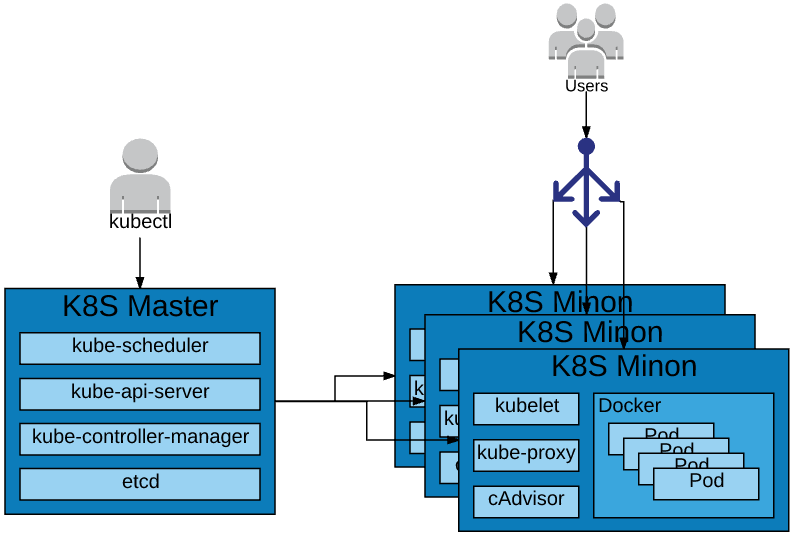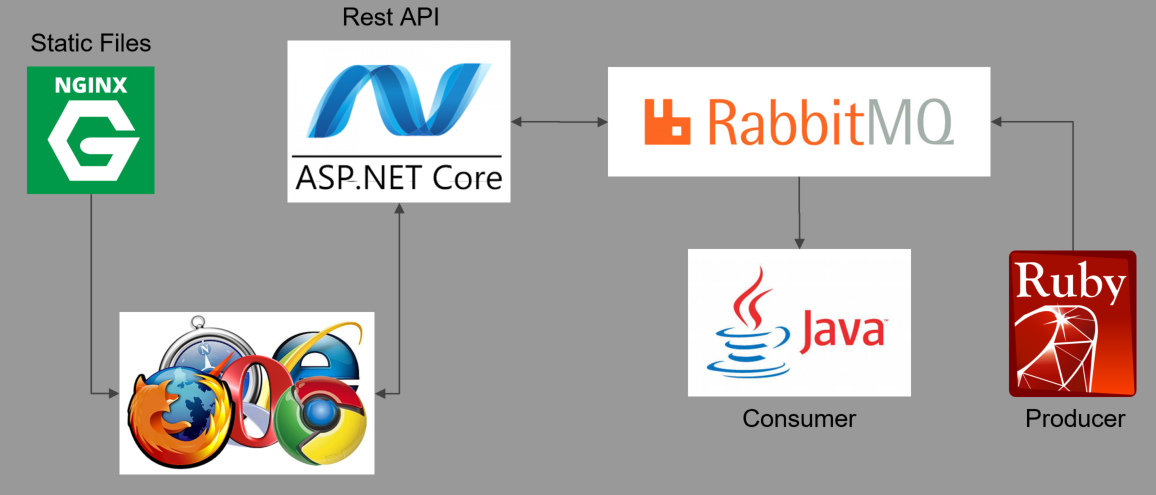Zero to DevOps in
Under an Hour with
http://slides.com/dalealleshouse/kube-azure


Who is this guy?
Dale Alleshouse
@HumpbackFreak
hideoushumpbackfreak.com
github.com/dalealleshouse
Agenda
-
What is Kubernetes?
-
Kubernetes Goals
-
Kubernetes Basic Architecture
-
Awesome Kubernetes Demo!
-
What Now?
What is Kubernetes?
- AKA K8S
- Greek for Ship's Captain (κυβερνήτης)
- Google's Open Source Container Management System
- https://github.com/kubernetes
- Lessons Learned from Borg/Omega
- K8S is speculated to replace Borg
- Released June 2014
- 1.0 Release July, 2015
- Currently in Version 1.6
- Highest Market Share
K8S Goals
- Container vs. VM Focus
- Portable (Run everywhere)
- General Purpose
- Any workload - Stateless, Stateful, batch, etc...
- Flexible (consume wholesale or a la carte)
- Extensible
- Automatable
- Advance the state of the art
- cloud-native and DevOps Focused
- mechanisms for slow monolith/legacy migrations
K8S Architecture

More Architecture Info
- Omega: flexible, scalable schedulers for large compute clusters
- https://research.google.com/pubs/pub41684.html
- Large-scale cluster management at Google with Borg
- https://research.google.com/pubs/pub43438.html
- Borg, Omega, and Kubernetes
- https://research.google.com/pubs/pub44843.html
- https://github.com/kubernetes/community
Demo System

https://github.com/dalealleshouse/zero-to-devops/tree/azure
Prerequisites
- Azure CLI
- https://docs.microsoft.com/en-us/cli/azure/install-azure-cli
- Docker
- https://www.docker.com/community-edition
Create Cluster
Create a new resource group
DNS_PREFIX=kube-demo
CLUSTER_NAME=kube-demo
az acs create --orchestrator-type=kubernetes --resource-group $RESOURCE_GROUP \
--name=$CLUSTER_NAME --dns-prefix=$DNS_PREFIX --generate-ssh-keysCreate Cluster
RESOURCE_GROUP=kube-demo
LOCATION=eastus
az group create --name=$RESOURCE_GROUP --location=$LOCATIONkubectl
# Install kubectl
sudo az acs kubernetes install-cli
# Authorize and configure for new cluster
az acs kubernetes get-credentials --resource-group=$RESOURCE_GROUP --name=$CLUSTER_NAMEInstall and configure
# View ~/.kube/config
kubectl config view
# Verify cluster is configured correctly
kubectl get csVerify
Deployments
- Deployments consist of pods and replica sets
- Pod - One or more containers in a logical group
- Replica set - controls number of pod replicas
# Create a deployment for three internal deployments
kubectl run java-consumer --image=dalealleshouse/java-consumer:1.0
kubectl run ruby-producer --image=dalealleshouse/ruby-producer:1.0
kubectl run queue --image=rabbitmq:3.6.6-management
# View the pods created by the deployments
kubectl get pods
# Run docker type commands on the containers
kubectl exec -it *POD_NAME* bash
kubectl logs *POD_NAME*Internal Services
Services provide a durable end point
# Notice the java-consumer cannot connect to the queue
kubectl get logs *java-consumer-pod*
# The following command makes the queue discoverable via the name queue
kubectl expose deployment queue --port=15672,5672 --name=queue
# Running the command again shows that it is connected now
kubectl get logs *java-consumer-pod*External Services
Create REST API Deployment and Load Balancer
# Create deployment
kubectl run status-api --image=dalealleshouse/status-api:1.0 port=5000
# Create Service
kubectl expose deployment status-api --port=80 --target-port=5000 --name=status-api \
--type=LoadBalancer
# Watch for service to become available
watch 'kubectl get svc'Create Load Balancer Service for Front End with env var pointing to REST API
kubectl run html-frontend --image=dalealleshouse/html-frontend:1.0 --port=80 \
--env STATUS_HOST=*STATUS-HOST-ADDRESS*
kubectl expose deployment html-frontend --port=80 --name=html-frontend --type=LoadBalancerInfrastructure as Code
The preferred alternative to using shell commands is storing configuration in yaml files. See the kube directory
# Delete all objects made previously
# Each object has a matching file in the kube directory
kubectl delete -f kube/
# Recreate everything
kubectl create -f kube/Default Monitoring
K8S has a default dashboard
kubectl proxyNavigate to http://127.0.0.1:8081/ui
Scaling
K8S will automatically load balance requests to a service between all replicas.
# Scale the NGINX deployment to 3 replicas
kubectl scale deployment html-frontend --replicas=3K8S can create replicas easy and quickly
Auto-Scaling
K8S can scale based on load.
# Maintain between 1 and 5 replicas based on CPU usage
kubectl autoscale deployment java-consumer --min=1 --max=5 --cpu-percent=50
# Run this repeatedly to see # of replicas created
# Also, the "In Process" number on the web page will reflect the number of replicas
kubectl get pods -l run=html-frontendSelf Healing
K8S will automatically restart any pods that die.
# View the html-frontend pods
kubectl get pods -l run=html-frontend
# Forcibly shut down container to simulate a node\pod failure
kubectl delete pod *CONTAINER*
# Containers are regenerated immediately
kubectl get pods -l run=html-frontend
Health Checks
If the endpoint check fails, K8S automatically kills the container and starts a new one
# Find front end pod
kubectl get pods -l run=html-frontend
# Simulate a failure by manually deleting the health check file
kubectl exec *POD_NAME* rm usr/share/nginx/html/healthz.html
# Notice the restart
kubectl get pods -l run=html-frontend...
livenessProbe:
httpGet:
path: /healthz.html
port: 80
initialDelaySeconds: 3
periodSeconds: 2
readinessProbe:
httpGet:
path: /healthz.html
port: 80
initialDelaySeconds: 3
periodSeconds: 2Specify health and readiness checks in yaml
Rolling Deployment
K8S will update one pod at a time so there is no downtime for updates
# Update the image on the deployment
kubectl set image deployment/html-frontend html-frontend=dalealleshouse/html-frontend:2.0
# Run repeadly to see the number of available replicas
kubectl get deploymentsViewing the html page shows an error. K8S makes it easy to roll back deployments
# Roll back the deployment to the old image
kubectl rollout undo deployment html-frontendDelete Demo
az group delete -n kube-demoWhat Now?
- K8S Docs
- https://kubernetes.io/docs/home/
- Free Online Course from Google
- https://www.udacity.com/course/scalable-microservices-with-kubernetes--ud615
- Callibrity Training (bstewart@callibrity.com)
- Maybe I can Help
- @HumpbackFreak

Thank You!
Zero to DevOps in Under an Hour with Kubernetes - Azure Edition
By Dale Alleshouse
Zero to DevOps in Under an Hour with Kubernetes - Azure Edition
The benefits of containerization cannot be overstated. Tools like Docker have made working with containers easy, efficient, and even enjoyable. However, management at scale is still a considerable task. That's why there's Kubernetes. Come see how easy it is to create a manageable container environment. Live on stage (demo gods willing) you'll witness a full Kubernetes configuration. In less than an hour, we'll build an environment capable of: Automatic Binpacking, Instant Scalability, Self-healing, Rolling Deployments, and Service Discovery/Load Balancing.
- 1,457



